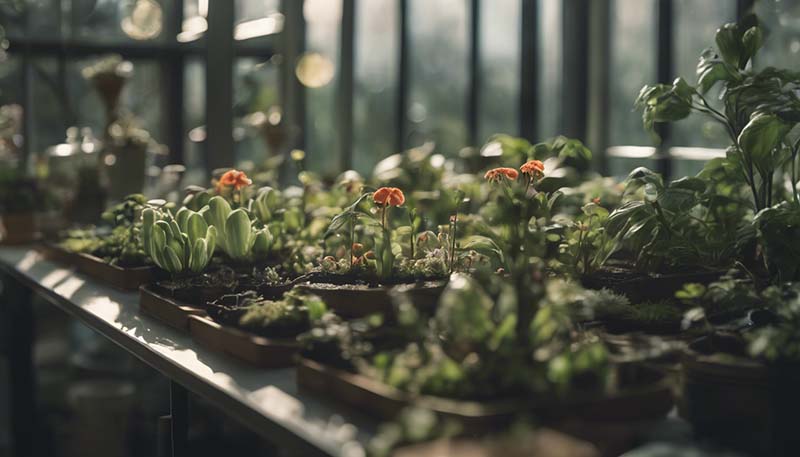The Science Behind Indoor Gardening: Understanding Plant Biology
Gardening indoors is a rewarding and fulfilling hobby that allows you to grow a variety of plants in the comfort of your own home. To become successful at indoor gardening, it's essential to understand the basic principles of plant biology. This knowledge will help you create an environment that supports the health and growth of your plants. In this article, we'll delve into the science behind indoor gardening and explore the factors that influence plant growth and development.
Photosynthesis: The Basis of Plant Growth
At the heart of plant biology is photosynthesis, the process by which plants convert light energy into chemical energy to fuel their growth. This process occurs in the chloroplasts, where chlorophyll, a green pigment, absorbs sunlight and uses it to convert carbon dioxide and water into glucose and oxygen.
Advertisement
Light Requirements
Light is a critical component of photosynthesis, and indoor gardeners must ensure their plants receive adequate light. The type and intensity of light can vary depending on the plant species. Some plants thrive in low light conditions, while others require bright, direct sunlight. Utilizing grow lights can help supplement natural light and provide the necessary spectrum for photosynthesis.
Water and Nutrients
Water is essential for plant growth, as it is involved in photosynthesis and transports nutrients from the soil to the plant's cells. Overwatering or underwatering can lead to problems, so it's crucial to understand the water requirements of each plant species. Nutrients are also vital for plant health. Indoor gardeners can use fertilizers to provide the necessary macro and micronutrients that support plant growth and development.
Respiration and Transpiration
In addition to photosynthesis, plants also engage in respiration and transpiration. Respiration is the process by which plants break down glucose to release energy for growth and cellular maintenance. Transpiration is the release of water vapor from the plant's leaves, which helps regulate temperature and maintain nutrient uptake.
Air Quality and Circulation
Good air quality and circulation are essential for optimal respiration and transpiration. Stagnant air can lead to the buildup of fungal spores and other pathogens. Indoor gardeners should ensure proper ventilation and consider using fans to improve air circulation around their plants.

Soil and its Role in Indoor Gardening
Soil is the medium in which most indoor plants grow. It provides anchorage, water, and nutrients. The composition of the soil can significantly impact plant growth. Different plants have different soil preferences, so it's essential to choose the right soil mix for each species.
pH and Soil Composition
The pH level of the soil affects the availability of nutrients to the plant. Most plants prefer a slightly acidic to neutral pH. Understanding the pH requirements of your plants and adjusting the soil accordingly can help ensure they receive the nutrients they need.
Temperature and Humidity
Temperature and humidity are critical factors that influence plant growth. Each plant species has its own optimal temperature and humidity range. Indoor gardeners can use heaters, air conditioners, and humidifiers to maintain the desired conditions.
Thermoregulation
Plants have mechanisms to regulate their temperature, such as opening and closing stomata. However, indoor gardeners must also play a role in thermoregulation by monitoring temperature fluctuations and adjusting the environment as needed.
Humidity Control
Humidity can affect the plant's ability to take up water and can also influence the growth of pathogens. Maintaining the right humidity levels is crucial, especially for plants that require high humidity, such as tropical species.
Plant Propagation and Reproduction
Understanding plant propagation is essential for expanding your indoor garden. There are several methods of plant propagation, including seed germination, cuttings, division, and layering. Each method has its own set of requirements and techniques.
Seed Germination
Seed germination is the process by which a plant grows from a seed. Factors that influence seed germination include temperature, moisture, and light. Providing the right conditions can help ensure successful germination and the growth of healthy seedlings.
Vegetative Propagation
Vegetative propagation involves the use of plant parts such as stems, leaves, or roots to produce new plants. This method is useful for plants that are difficult to propagate from seed. Cuttings, division, and layering are common vegetative propagation techniques.
Conclusion
Indoor gardening is a complex and rewarding endeavor that requires a deep understanding of plant biology. By grasping the principles of photosynthesis, respiration, transpiration, and the factors that influence plant growth, you can create an environment that supports the health and development of your indoor plants. With careful attention to light, water, nutrients, soil, temperature, humidity, and propagation techniques, you can enjoy a thriving indoor garden all year round.
Comment